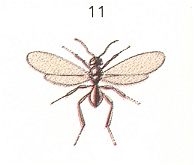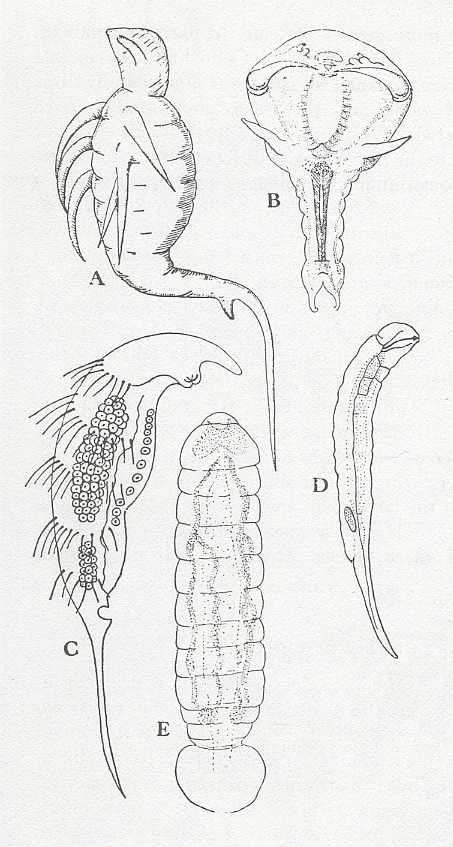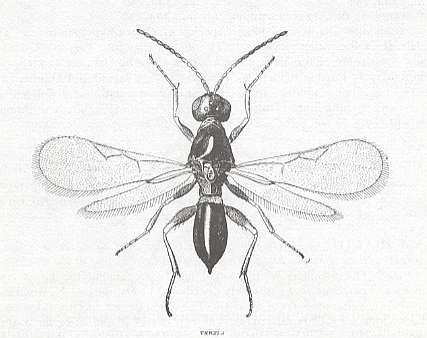
Organic Evolution in terms of the Implicate and Explicate Orders.
Part XLI
Hymenoptera (wasps, bees, ants) (Sequel)
The evolutionary diversification in the Order Hymenoptera in terms of Strategies (Sequel).
Hypermetamorphosic-parasitic phase
In some terebrants, laying their eggs into host-eggs, and develop inside the preys, from the egg a most peculiar larva emerges. Its overall look is unlike that of an insect larva, but rather lets us think of a Cyclops [= a crustacean], or even of a trochophora, or something like it. Such are, for example, the cyclopoid larvae of Platygasteridae [see next Figure], the telea-like larvae of the Scelionidae, and the eucoili-formed larvae of the parasitic gall-wasp-related Eucoilidae [see Figure 2 and 3].

Figure 1 : Platygaster zosina Wlk. Size ca. 1 mm. Family Platygasteridae.
(After CHINERY, in Elseviers Insektengids voor West-Europa, 1983)

Figure 2 : Primary larvae of various parasitic Hymenoptera.
A - eucoiliform (Eucoila). (After KEILIN and PLUVINEL).
B - cyclopiform (Trichacis). (After MARCHAL).
C - teleaform (Teleas). (After AYERS).
D - caudate (Mesochorus). (After SEURAT).
E - vesiculate (Microgaster). (After RICHARDS and DAVIES).
All highly magnified.
(In RICHARDS and DAVIES, Imms' General Textbook of Entomology, 1977)

Figure 3 : Eucoila eucera, female.
According to RICHARDS and Davies this form belongs to the family Cynipidae. According to MALYSHEV it belongs to the family Eucoilidae, but as such still belonging to the superfamily Cynipoidea.
(In RICHARDS and DAVIES, Imms' General Textbook of Entomology, 1977)
Such complexifications in the development of terebrants are not seldom interpreted as representing some sort of hypermetamorphosis, although a true hypermetamorphosis was described by Fabre only for beetles of the family Meloidae, where it has become still more complex by the insertion of a special larval resting state, or "pseudo-pupa", which is absent in the mentioned terebrants.
The here considered peculiar first-instar larvae were interpreted by Wheeler (1928) as being transformed planidia. It is in fact hard to suppose that the unusual morphological features of these larvae could, from the beginning to the end, develop exclusively under the conditions of internal parasitism [The here considered "hypermetamorphosic" larvae are found among those terebrants that, as larvae, live inside their prey]. It is much more easier to suppose something else, namely that these endoparasitic larvae are derivates of such forms that formerly lived outside one or another host. However, it is very problematic to suppose that the original form was a planidium. As we already know, the origin of the planidial stage is connected with the development in the female of the terebrant of a special instinct -- laying of the egg on a non-nutritive substrate and thereby in such places, where its larvae, adapted to live in an open environment, would be able to independently find or reach their prey. The supposition of Wheeler assumes, consequently, a transition of highly specialized forms [planidia] to conditions that are totally alien to them, that is, to [the condition of] laying the egg inside the prey, and to the development of the larva [directly] inside the latter.
It is simpler to suppose yet again something else in these matters, namely that the instincts of the females of the archaic inquilines had evolved faster than had the adaptation of their original many-legged larvae to parasitism inside preys. [The females already laid their eggs i n s i d e the host, before the larvae were (evolutionarily)[morphologically] adapted to a life inside a strange organism.]. In such conditions, without, as a preparation, going through a planidial stage, the delay of the archaic larvae in adapting themselves to a life inside a strange organism [i.e. being too late with the adaptation], precisely gave rise to these peculiar "hypermetamorphosic" [the text says "hyperparasitic"] forms. In this way we might, apparently, also think of the peculiar endoparasitic larvae of the Mymaridae.
And thus, in the given quasi-hypermetamorphosic phase we do not uncover any special changes of the instincts of the adult insect, but only see the result of a peculiar, and as it were overhasty adaptation [chiefly physiological, I assume] of their larvae to a life inside their prey. [That is, the instinct of the females had rapidly changed into laying the egg i n s i d e the prey, directly followed by a quick physiologic adaptation of already the first-staged larva which, however, has not yet changed morphologically.]
With all this we have concluded our exposition of the Hypermetamorphosic-parasitic phase of hymenopterous evolution.
In the next document we will expound the Polyembryonic-parasitic Phase.
e-mail :  ( Please write in ' Subject ' entry : ' METAPHYSICS ', in order for me to be able to distinguish your mail from spam )
( Please write in ' Subject ' entry : ' METAPHYSICS ', in order for me to be able to distinguish your mail from spam )
To continue click HERE for the further study of Organic Evolution, Part XLII.
Back to Homepage
Back to Contents
Back to Evolutionary Part XIV
Back to Evolutionary Part XV
Back to Evolutionary Part XVI
Back to Evolutionary Part XVII
Back to Evolutionary Part XVIII
Back to Evolutionary Part XIX
Back to Evolutionary Part XX
Back to Evolutionary Part XXI
Back to Evolutionary Part XXII
Back to Evolutionary Part XXIII
Back to Evolutionary Part XXIV
Back to Evolutionary Part XXV-A
Back to Evolutionary Part XXV-B
Back to Evolutionary Part XXV-C
Back to Evolutionary Part XXVI
Back to Evolutionary Part XXVII
Back to Evolutionary Part XXVIII
Back to Evolutionary Part XXVIII-A
Back to Evolutionary Part XXIX
Back to Evolutionary Part XXX
Back to Evolutionary Part XXXI
Back to Evolutionary Part XXXII
Back to Evolutionary Part XXXIII
Back to Evolutionary Part XXXIV
Back to Evolutionary Part XXXV
Back to Evolutionary Part XXXVI
Back to Evolutionary Part XXXVII
Back to Evolutionary Part XXXVIII
Back to Evolutionary Part XXXIX
Back to Evolutionary Part XL





 ( Please write in ' Subject ' entry : ' METAPHYSICS ', in order for me to be able to distinguish your mail from spam )
( Please write in ' Subject ' entry : ' METAPHYSICS ', in order for me to be able to distinguish your mail from spam )